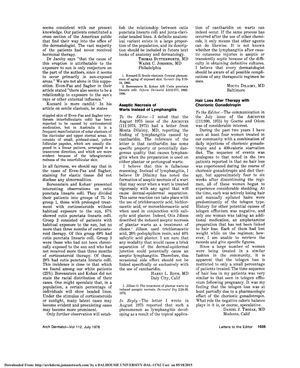Hair Loss After Therapy with Chorionic Gonadotropin
July 1976
in “
Archives of Dermatology
”

TLDR Some women experienced hair loss after stopping chorionic gonadotropin injections and a low-calorie diet.
The document discusses various dermatological conditions and their potential causes, including the relationship between sun exposure, corticosteroid therapy, and the development of cutis punctata linearis colli. It also addresses the phenomenon of lymphangitis following the application of cantharidin on warts, suggesting that it may not be unique to cantharidin but could occur with other agents causing dermal-epidermal separation. The main focus, however, is on hair loss following therapy with chorionic gonadotropin. Dr. Daniel J. Trozak reports observing four women who experienced considerable hair shedding four to six weeks after discontinuing a regimen of daily chorionic gonadotropin injections and a 400-calorie diet. The hair loss pattern was similar to telogen effluvium seen post-pregnancy, and it was speculated that the hair loss could be partially due to the pharmacologic effects of chorionic gonadotropin, with the role of negative caloric balance remaining speculative. The incidence of telogen loss was noted to be a small percentage of the treated patients, indicating that it does not affect all individuals undergoing such treatment.




